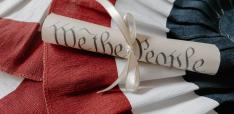Economically Sacred Cows: Beef as Luxury Consumption
Karl Muth argues that the story of beef is an interesting one because it involves the ultimate trade-off in agrarian societies. To understand why, we have to go back to the Bronze Age. Well, not really. We could go see how about three billion people live.
The farmers I study live in northern Uganda. I model the farms they run as businesses (and they are businesses, no doubt) and one of the crucial decisions in all businesses is the trade-off (“substitution” in economics-speak) between labour and capital. To understand this, visualise a task that could be done by a lot of people or fewer robots, like painting cars on an assembly line. The ratio of people to robots is your substitution curve, which is nearly always concave (the substitution curves of the management of the Starship Enterprise are probably convex, but let’s just say that would be highly unusual).
Why am I talking to you about economics when you thought you’d clicked a blog about hamburger?
Well, the main piece of capital equipment the farmers I study can buy (and the farming techniques in these regions have not changed a lot since the Bronze Age) is the oxplough. Now, the oxplough we’re talking about isn’t a complex thing. It’s a simply row of chisels and shares, normally five or six, that get dragged through the dirt by a draught animal (Colonial English: dray animal). Draught horses never took hold in this part of the world and the few horses that were of baroque lineage and brought accompanied British officers and were hence better-suited to dressage than ploughing. In fact, such horses suffered terribly in the heat and many died before seeing a single parade, let alone a standing season on garrison. This left cattle as the only viable draught animals.
It is not pleasurable, and even dangerous, to eat older or ill cattle. Cows are close enough to humans in their blood chemistry and cardiovascular disposition to play host to many parasites and viruses that afflict humans. Hence, only healthy cows are good candidates for slaughter. Also, only healthy cows are good candidates for ploughing. This means that to eat a cow is particularly lavish, as it destroys a potential draught animal. It also destroys one of the few viable stores of value poor regions of the world where currency volatility (primarily short-term hyperinflation) is installed in the recent memories of all.
If this attitude toward beef were unique to northern Uganda, it would be an anthropological oddity. But it is not. The history of how beef became a luxury item in northern Argentina is very similar. As is the history of beef in Cantonese cooking, where cattle were rarely available and highly sought-after, particularly northern (erroneously: “Mongol”) varieties of cattle which were thought to be stronger. In the old Shandong cooking traditions (now revived and increasingly popular in Beijing), beef is specifically referred to as a spice or a flavouring, and not as a substantive ingredient. The predecessor state laws to the Humane Slaughter Act in the United States (7 U.S.C. 1901 et seq.) consistently and explicitly recognised the trade-off between keeping cattle (particularly draught animals, American: plow oxen) and related bovines for meat versus ploughing. And even in the remote upper regions of the Andes, there is substantial discussion of the trade-off between eating and using cattle.
There is no animal more useful for its input cost than the cow. It eats only twice as much as a goat in normal grazing conditions and generates nearly six times the horsepower. It can plough longer than smaller bovines, such as the Under Bollock and Lesser Black Ox (alluded to as weak since Biblical times, as in Proverbs 15:17), and it can work in heat that would frustrate even determined men. Its ability to tow a plough is unaffected by terrain except for gathered pools or the steepest grades. To eat a draught animal has been for centuries, and remains, the ultimate luxury in the agrarian lifestyle. And by destroying a store of value at the same time, it is doubly extravagant – hedonistic consumption and destruction of monetary value, the African agricultural analogue to Snoop Dogg’s (err… sorry, Calvin, I know now you want to be called Snoop Lion…) famous habit of smoking joints made of $100 notes.
The prevalence of refrigeration changed this equation in the developed world. Suddenly, beef could be moved frozen or in refrigerated form. The invention of thermoplastic hermetic packaging in the late 1970’s allowed beef to be sealed and frozen, moving the shelf transport life of cow meat from two days to three months. Factory and efficient-operations slaughterhouses in the late 1970’s and early 1980’s increased the total quantity of beef available, eventually meeting demand at middle-class prices. If we take a look at 1950’s and 1960’s American cinema, we see bigshot gangsters and corporate kings having steak every night as a sign of wealth and power. By the mid-1980’s, this nearly vanishes. The steak dinner as a sign of status was so important in post-war America that it shows up in vintage dramas from stageplays to the ever-popular Mad Men serial. The rise of the red meat factory, the one-dollar hamburger, and the television dinner killed the concept of beef as a luxury good in America. The financial difficulties of Scotland, the rise of discount chain grocers, and the subsidies for staples in the pre-Thatcher era achieved the same in the United Kingdom, for very different reasons and with somewhat different results.
But for roughly five and a half billion people, beef remains not a question of appetite or taste, but a question of luxury, extravagance, and conspicuous consumption. It remains a question of using cattle as tools or using cattle for a one-time dividend of high-quality, high-density protein. It remains a question of spending. It remains a question, and a choice, only available to the rich.


